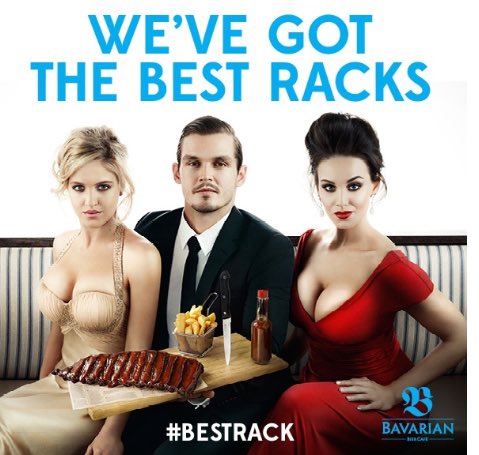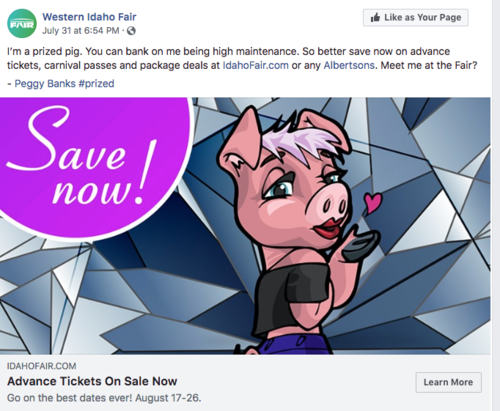Objectification of women is an action so deeply ingrained in us that it does sit on a spectrum of least to most visible. However some of the images under Carol J Adams website jumped out at me as outrageous, one of them was the “we’ve got the best racks” image. I nearly gasped when I was scrolling through because it was so clear the imagery and marketing was trying to convey. The women in this particular image are looking straight to camera, they are outfitted in dresses that show their cleavage. Also the word “racks” has several connotations, one meaning referring to a cut of meat and the other to parts of a woman’s body. I make a note on the placement of both of these images because the women are both looking straight to the camera but their bodies are gravitating towards the rack of meat on the table situated beneath them.
to camera, they are outfitted in dresses that show their cleavage. Also the word “racks” has several connotations, one meaning referring to a cut of meat and the other to parts of a woman’s body. I make a note on the placement of both of these images because the women are both looking straight to the camera but their bodies are gravitating towards the rack of meat on the table situated beneath them.
What do we learn from the objectification of women and animals? This week the beginning of the reading spoke about hierarchies and when I applied the ideas of both objectification, hierarchies, and patriarchy I saw it clearly in the image. The man (patriarchal figure) is sitting center stage like a, “symbol for what is not seen but is always there… patriarchal control of animals” (Adams, 3) while the women’s bodies, in this case, are being used as objects under the male gaze. The objectification of women and women’s bodies in this image is used as a tool to sell non-human animals. Adams also acknowledges around page 8-9 that there is a hierarchy with humans and non humans. I can visually see and thus rank where all parties are placed in the image. The animal meat is the lowest of all three objects in this picture. The order may look a bit like this: the man is centered and unbothered, then the bodies of the two women, then the meat. In this regard I believe the consumer is male targeted. While the consumed is the women and/or animal meat because, “women are animalized and animals are sexualized and feminized” (Adams, 13). When power struggles that position people and animals to be either eaten or do the eating there are two outcomes in that scenario.
This image sexualizes the pig in the same way we sexualize women. Verbiage like “high maintenance” is used to associate the value of women who are deemed better to the value of feminized pig or even more subtle verbiage like “advance” in this context.

I also learned from Adams that, “consumption is the fulfillment of oppression, the annihilation of will, of separate identity” (page 14). So I believe that objectification is a tool of oppression. Just as the term anthropornography that Adams’ coined can be used to describe what is happening in this image of the feminine pig.
 This was one of the images this week that while filtering through the slideshow my mouth fell open in shock. It is peak objectification and extremely dehumanizing to women. I’m reminded of the point that Adams was making around page 7 about dehumanization as a tactic “ when a group is deemed not human, oppressors have several options for establishing just who they see them as” (Adams, 7). About women first needing to be seen as human to not be objects of the male gaze. But this meme would suggest through sexually charged comparison that women can be served up like we do meat. All of this is based on a hierarchy of species, that is outlined from most powerful to to least.
This was one of the images this week that while filtering through the slideshow my mouth fell open in shock. It is peak objectification and extremely dehumanizing to women. I’m reminded of the point that Adams was making around page 7 about dehumanization as a tactic “ when a group is deemed not human, oppressors have several options for establishing just who they see them as” (Adams, 7). About women first needing to be seen as human to not be objects of the male gaze. But this meme would suggest through sexually charged comparison that women can be served up like we do meat. All of this is based on a hierarchy of species, that is outlined from most powerful to to least.
Adams illustrates this on page 8. I have listed the order of living things under speciesism below:
Top 3
▶️human being
▶️Subhumans
▶️The devil
Bottom 3
▶️ Reptiles
▶️ Insects
▶️ “Material” nature- Earth
 This particular image jumped out at me because it clearly is not only sexualizing women but adds another layer of manipulation because it implies that women are inherently more dishonest than men and/or lying to men about their needs with to cis gendered men. Also as far as imagery goes the biggest thing in this photo is the food. This is also a more current marketing as far as some of the other photos we looked at go. This idea that food marketing that centers the objectification of marketing will have very similar points to it because, “advertisements that sexualize and feminize animals have been around for more than thirty years, and during this time, they have become more widespread and more explicit” (page 14). Back to my initial feelings about seeing this image from at least from 2000’s of a famous socialite, it is very sexualized, Paris Hilton in a bathing suit and comments like “it’s gonna get messy”, all added to enhance the sexual nature of women.
This particular image jumped out at me because it clearly is not only sexualizing women but adds another layer of manipulation because it implies that women are inherently more dishonest than men and/or lying to men about their needs with to cis gendered men. Also as far as imagery goes the biggest thing in this photo is the food. This is also a more current marketing as far as some of the other photos we looked at go. This idea that food marketing that centers the objectification of marketing will have very similar points to it because, “advertisements that sexualize and feminize animals have been around for more than thirty years, and during this time, they have become more widespread and more explicit” (page 14). Back to my initial feelings about seeing this image from at least from 2000’s of a famous socialite, it is very sexualized, Paris Hilton in a bathing suit and comments like “it’s gonna get messy”, all added to enhance the sexual nature of women.
Hi Jillian!
The first image that you have chosen from Adams website is a really great example of how the food industry has passively but yet openly objectified women over the years and across different kinds of setting, to sell different kinds of foods. The women in the picture look very seductive, to sell the ‘mouthwatering’ meat that they are trying to advertise. When reading your post, you make a good point that I hadn’t thought about before. You mentioned that the non human animal meat is at the lowest point in the photo and yet, the women’s breasts and body language have been crafted in such a way that it makes ones eyes just look downward, if not at their breasts, to the meat itself. To further my point, both of the women’s breasts are facing downward (almost at the same level as the meat) so that one’s gaze is more magnified to their breasts and to the meat, equalizing them both in a sense. The man is fully clothed and is sitting in the middle as you have pointed out, making him the center of attention if not on the meat or the breasts. I like the way that you descried the photo and brought Adams into the discussion to further help analyze the meaning behind the objectification of women.
In your analysis of the cheeseburger add that you posted, I agree 100% with your viewpoint on the advertised implication towards women and how men will perceive this add. I hate the fact that this add objectifies women and exploits a false generalization about what women ‘really’ want. Carol talks about in her writing that this kind of image relates to the public but more specifically to men, with the message that women are very sexually available, and that they want sex, because they want the ‘bigger’ size that they are ‘clearly’ lying about. Thanks for the good read!